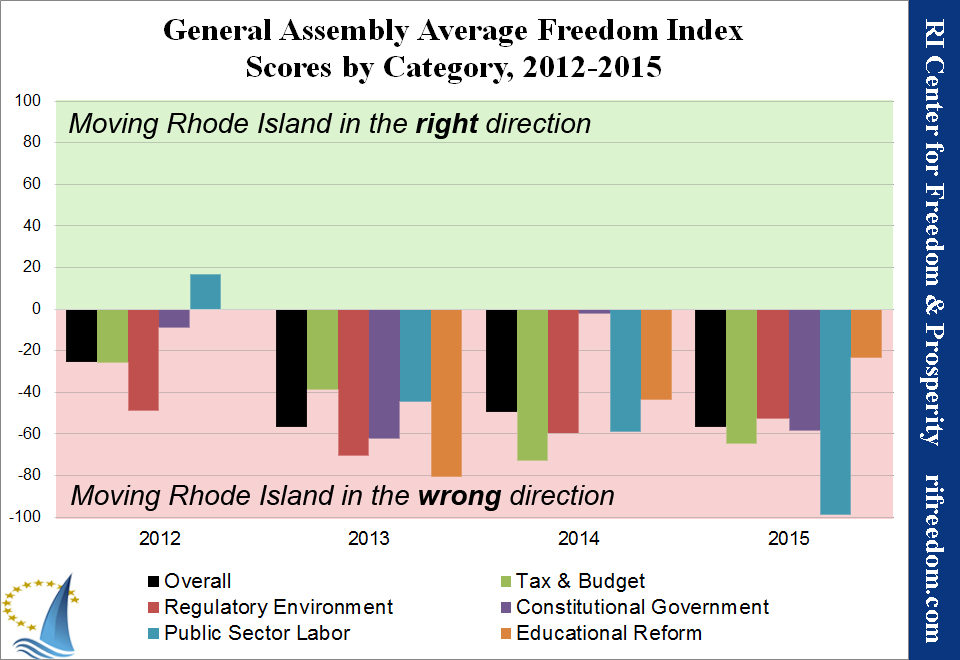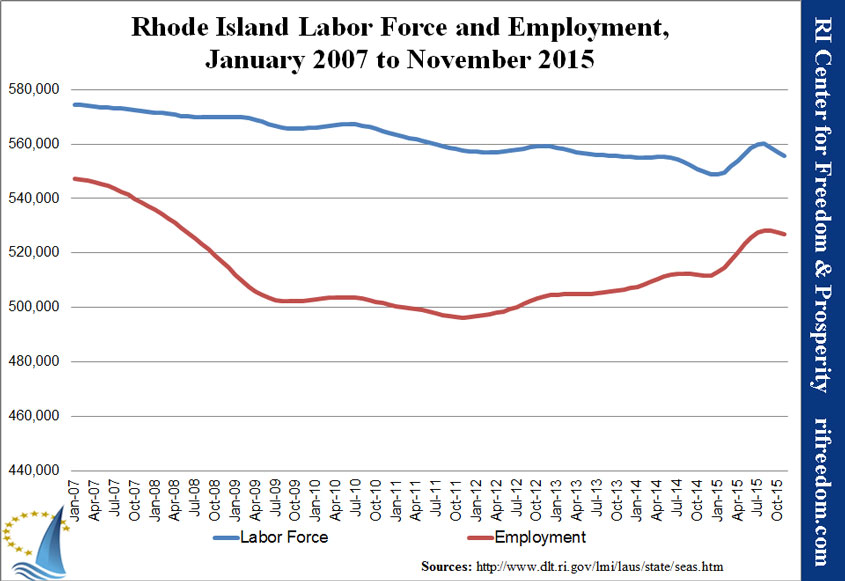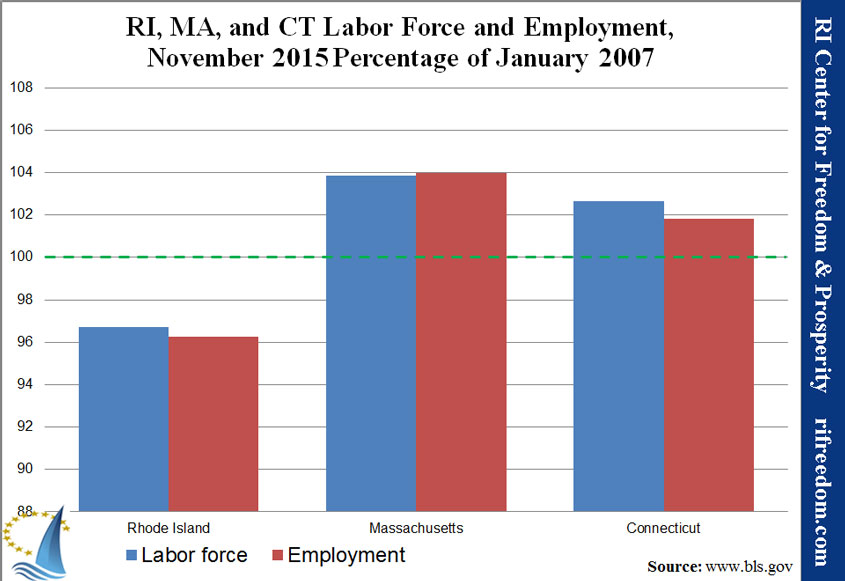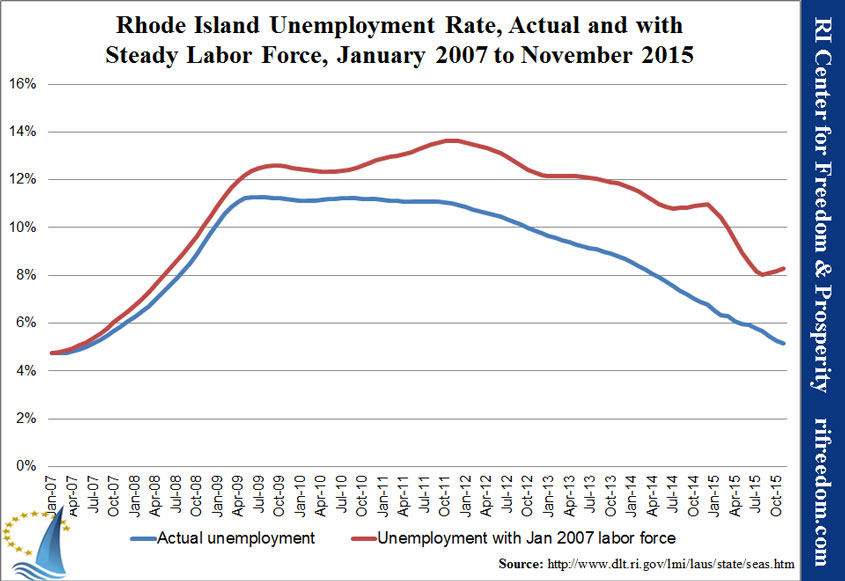Center’s Scholarship Legislation Part of Thursday’s State House Celebration of National School Choice Week
/in Education, Recent Posts/by RI Center for FreedomUS SUPREME COURT & RI: Backgrounder Report on Right-To-Work Friedrichs & RI Case
/in Labor, News, Recent Posts/by RI Center for FreedomFriedrichs Vs. California Teachers Association
/in Blog, Labor, Political Philosophy, Recent Posts/by RI Center for FreedomTHE RI FREEDOM INDEX: Legislators Challenged to Improve on Dismal 2015 Results
/in Studies and Reports, Taxes/by Mike StenhouseSTATEMENT: Senate 11 Election, State House Rally Prove Supporting Tolls is Political Suicide
/in Infrastructure, Recent Posts, Taxes/by RI Center for FreedomSTATEMENT: Center Supports STOP TOLLS RI Rally. Concerns re. Big-Dig Type Cost Over-runs
/in Infrastructure, Policy, Recent Posts/by RI Center for FreedomNOVEMBER JOBS SNAPSHOT: Lower Unemployment Rate Paints Inaccurate Picture
/in Jobs, Recent Posts/by RI Center for FreedomFOR IMMEDIATE RELEASE
December 21, 2015
RI Unemployment Rate Again Paints False Picture
Center to publish new Jobs & Opportunity Index in 2016
Providence, RI — For the second month in a row, the November unemployment rate for Rhode Island appears to paint an incomplete and misleading snapshot of the true jobs and economic picture in the state, according to a monthly analysis by the nonpartisan RI Center for Freedom & Prosperity. As in October, the lower state unemployment rate, seemingly a positive, was the result of two negative pieces of data: lower overall employment and a smaller labor force (a result of people giving up looking for work).
While the U.S. Bureau of Labor Statistics (BLS) measures six levels of unemployment, U1 thru U6, it is only the U3 unemployment rate that is the basis for the official monthly unemployment rate: U3 narrowly measures the number of unemployed people as a percentage of the labor force. However, U3 is largely dependent on labor force size; so in keeping with the trend of recent months in Rhode Island, when the labor force drops, usually considered a negative economic indicator, it generally produces a lower U3 unemployment rate, which is conversely seen as a positive.
In November of 2015, Rhode Island’s unemployment rate dropped to 5.2%, from 5.3% in the prior month. But, similar to October data – employment levels actually dropped (by 770 people) and 1,461 Rhode Islanders gave up looking for work, thus shrinking the labor force.
“To hear politicians crow about our state’s lower unemployment rate is misguided,” said Research Director Justin Katz, “two losses don’t make a real gain; and this pattern has persisted for years. There’s much more going on in our state that lawmakers should be aware of.”
Among the specific findings in the November analysis:
- RI’s unemployment rate would have increased to 8.3% if the state had maintained the same size labor force at it had before the recent recession
- RI lags far behind its MA and CT neighbors in terms of recovering its employment and labor force levels since before the recent recession
For graphs, charts and a more detailed analysis of Rhode Island’s November employment status click here.
New JOI Index in 2016: In order to account for this labor force vs unemployment rate contradiction and to provide Rhode Islanders with a broader and more accurate picture of the state’s actual jobs market, in Q1 of 2016, the Center plans to publish a monthly Jobs & Opportunity Index, which will incorporate other BLS unemployment categories and which will also measure the size and scope of the state’s private sector as compared with the size and scope of state government.
Rhode Island Employment Snapshot, November 2015: Expected Down Note as Last Report of the Year
/in Blog, Jobs, Recent Posts/by Justin Katz[Click here for the printable one-page PDF of this post.]
The trend that has come to define Rhode Island’s employment picture in 2015 (indeed, since the end of the recession) continued for the final Bureau of Labor Statistics (BLS) report for the year. In November, Rhode Island’s unemployment rate dropped to 5.2%, from 5.3% in October. That’s 28 straight months of decreases in the rate of at least one-tenth of one percent. As usual, however, the positive rate resulted from two bits of negative data. Employment actually dropped by 770 people, but 1,461 Rhode Islanders stopped looking for work.
The first chart shows that November’s results continued a downturn in Rhode Island’s underlying employment results. Although the annual revision due next month may shift the picture quite a bit, the state’s labor force (those employed or actively looking for work) is nearly back where it was in the middle of 2014, erasing both a sharp downturn at the end of that year and an even bigger increase for the first half of this year.
November was another month in which New England was almost unique in losing employment, with all six states bucking a national trend of increases. The columns in the second chart are consequently smaller for both Massachusetts and Connecticut, this month, but Rhode Island remains the only Southern New England state well below its January 2007 level of employment and labor force.
The third chart illustrates the fundamental problem of the official unemployment rate. The red line shows what Rhode Island’s unemployment rate would have been if the labor force had not shrunk since January 2007. As of November, the unemployment rate would actually be going back up, having never dipped below 8%. For November, it would have increased to 8.3%.
Statement: Ocean State Jobs Picture Not As Rosy As It Seems
/in Issues, Jobs, News, Recent Posts/by RI Center for FreedomFOR IMMEDIATE RELEASE
November 25, 2015
RI Employment Picture Tainted by Dwindling Labor Force
Center to publish new quarterly jobs index in 2016
Providence, RI — The traditional monthly unemployment rate, widely reported by most news outlets, often paints an incomplete and misleading snapshot of the true jobs and economic picture in the state, according to a monthly analysis by the nonpartisan Rhode Island Center for Freedom & Prosperity.
While the U.S. Bureau of Labor Statistics (BLS) measures six levels of unemployment, U1 thru U6, it is only the U3 unemployment rate that is regularly cited: U3 narrowly measures the number of unemployed people as a percentage of the labor force. However, U3 is largely dependent on labor force size; so when the labor force drops, usually considered a negative economic indicator, it generally produces a lower U3 unemployment rate, which is conversely seen as a positive.
For instance, in October of 2015, Rhode Island’s unemployment rate dropped, from 5.4% in September, to 5.3% in October. But, as has often been the case, that apparent positive outcome is the result of two negative trends; employment levels actually dropped (by 630 people) and 1,636 Rhode Islanders gave up looking for work, thus shrinking the labor force.
“The falling unemployment rate is the one statistic that Rhode Island politicians like to cite as evidence of economic progress,” said Research Director Justin Katz, “but two losses don’t make a gain. If our state’s poor business climate hadn’t driven so many people out of its labor force since the recession, unemployment would never have dipped below 8%, and it would be on its way back up, right now.”
Among the specific findings in the October analysis:
- RI’s unemployment rate would be 8.2% if the state had maintained the same size labor force at it had before the recent recession
- RI lags far behind its MA and CT neighbors in terms of recovering its employment and labor force levels since before the recent recession
For graphs, charts and a more detailed analysis of Rhode Island’s October employment status click here.
In order to account for this contradiction and to provide Rhode Islanders with a broader and more accurate picture of the state’s actual jobs market, in Q1 of 2016, the Center plans to publish a quarterly Jobs Opportunity Index which will incorporate all six BLS Unemployment categories. The other BLS U-categories more broadly take into account such measurements as underemployed and discouraged workers; people who are willing to work, but for whatever reason, have not looked for work or who are working only on a part-time basis – yet who do not fit the narrow U3 definition of “unemployed”.
Media Contact:
Justin Katz
401-835-7156 | jkatz@oceanstatecurrent.com
Mike Stenhouse, CEO
401.429.6115 | info@rifreedom.org
About the Center
The nonpartisan RI Center for Freedom & Prosperity is Rhode Island’s premiere free-enterprise research and advocacy organization. The mission of the 501-C-3 nonprofit organization is to return government to the people by opposing special-interest politics and advancing proven free-market solutions that can transform lives by restoring economic competitiveness, increasing educational opportunities, and protecting individual freedoms.




